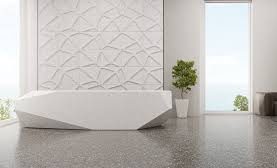Terrazzo flooring is a popular choice for both residential and commercial spaces due to its unique and stylish appearance. Made from a combination of marble or granite chips embedded in a cement or epoxy binder, terrazzo offers a durable and versatile flooring option. In this guide, we will explore the pros and cons of terrazzo flooring to help you make an informed decision.
Pros of Terrazzo Flooring:
Aesthetically Pleasing: One of the major advantages of terrazzo flooring is its aesthetic appeal. It offers a wide range of design possibilities with various color combinations and patterns. The polished surface of terrazzo creates a smooth and glossy finish that adds a touch of elegance and sophistication to any space. It can be customized to match your unique style and complement the overall interior design.
Durability and Longevity: Terrazzo is renowned for its exceptional durability. It can withstand heavy foot traffic, making it suitable for high-traffic areas such as commercial buildings, schools, and airports. The combination of marble or granite chips with a strong binding material makes terrazzo resistant to scratches, stains, and wear, ensuring its longevity and minimizing the need for frequent repairs or replacement.
Low Maintenance: Terrazzo flooring requires minimal maintenance, making it an attractive option for busy households or commercial spaces. Regular sweeping or vacuuming, along with occasional damp mopping, is typically sufficient to keep the surface clean and well-maintained. The smooth and non-porous nature of terrazzo prevents the accumulation of dust, allergens, and bacteria, making it a hygienic flooring choice.
Versatility: Terrazzo offers versatility in design and application. It can be installed in various spaces, including kitchens, bathrooms, living areas, and outdoor patios. Additionally, terrazzo can be used for countertops, wall panels, and even furniture, allowing for a cohesive and integrated design scheme throughout your space.
Eco-Friendly Option: Terrazzo flooring is considered environmentally friendly due to its composition. It often incorporates recycled materials, such as crushed glass or aggregates from demolished buildings, reducing waste and promoting sustainability. The longevity of terrazzo also minimizes the need for frequent replacements, reducing the environmental impact associated with manufacturing and disposing of flooring materials.
Excellent Heat Conductivity: Terrazzo has excellent heat conductivity properties, making it an ideal choice for homes with underfloor heating systems. It efficiently conducts and retains heat, providing comfortable warmth throughout the space. This feature can help to reduce heating costs and create a cozy environment, especially during colder months.
Cons of Terrazzo Flooring:
Initial Cost: One of the primary drawbacks of terrazzo flooring is its initial cost. Compared to other flooring options, such as vinyl or laminate, terrazzo can be more expensive to install. The cost depends on factors such as the quality of materials, complexity of design, and the size of the area to covered. However, it’s important to consider the long-term benefits and durability of terrazzo, which may outweigh the initial investment.
Susceptible to Cracking: While terrazzo is highly durable, it is not completely resistant to cracking. Factors such as heavy impacts, settling of the building foundation, or improper installation techniques can lead to cracks in the flooring. However, with proper maintenance and timely repairs, the longevity of terrazzo can be preserved.
Slippery When Wet: Polished terrazzo can become slippery when wet. Which can pose a safety hazard, particularly in areas prone to spills or moisture. It’s important to use mats or rugs in areas where water is likely to accumulate. Such as entryways or bathrooms, to minimize the risk of slips and falls. Additionally, applying an anti-slip coating or using textured terrazzo can improve traction and reduce the slipperiness.
Labor-Intensive Installation: Installing terrazzo flooring requires skilled professionals with expertise in terrazzo installation techniques. The process involves pouring the cement or epoxy mixture, embedding the marble or granite chips, and polishing the surface to achieve the desired finish. The labor-intensive nature of the installation can extend the project timeline and increase the overall cost.
Vulnerability to Acidic Substances: Terrazzo is susceptible to etching or staining when exposed to acidic substances. Such as citrus juices, vinegar, or certain cleaning agents. It’s important to promptly clean up spills and avoid using harsh chemicals that can damage the surface. Regular sealing and proper maintenance can help protect the terrazzo and prevent staining.
In conclusion,
Terrazzo flooring offers numerous advantages, including aesthetic appeal, durability, low maintenance, versatility, eco-friendliness, and heat conductivity. However, it’s essential to consider the initial cost, susceptibility to cracking, and slipperiness. When wet, labor-intensive installation, and vulnerability to acidic substances. By weighing these pros and cons, you can determine whether terrazzo flooring is the right choice for your specific needs and preferences.

